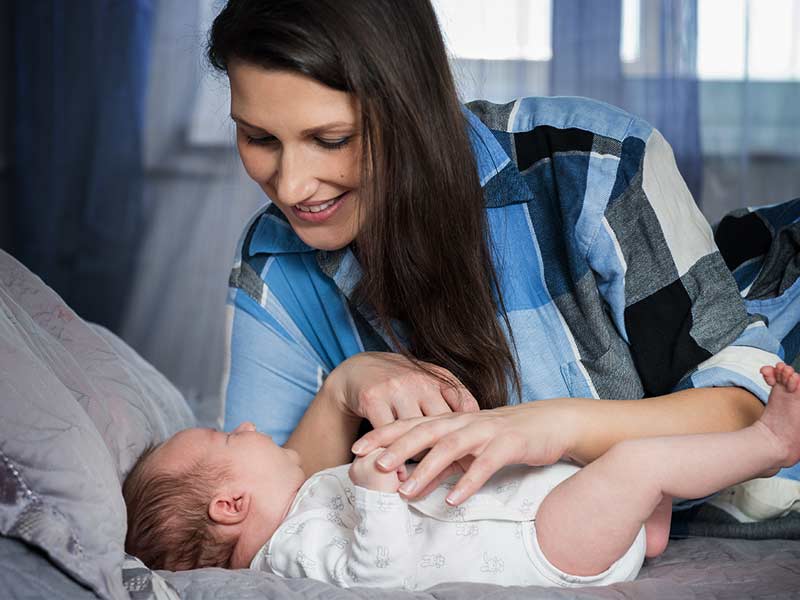
Taking care of a little man every day brings his parents a lot of joy, excitement, but also responsibility and experience. Especially when a baby for the first time scares Mom and Dad with a strong burp or just a big burp. Can you start wondering if my baby is all right? Isn’t there something bothering him?
What is a burp?
In infants, regurgitation is defined as the spontaneous discharge of a small amount of food just eaten (milk or a mixture) into the baby’s mouth from the stomach.
Types of regurgitation in newborn babies.
- belching – the discharge of air captured by the baby at mealtimes, as a rule, a small volume of milk or mixture is released;
- regurgitation – the food received and the air with it comes out very abundantly. This happens at the same time as the meal ends or after a short period of time.
- vomiting is similar to regurgitation, but there are a number of features. The child is capricious, crying, becomes sleepy, lethargic. There is a complete loss of appetite and unwillingness to eat.
Reasons for regurgitation
1. Physiological:
- short oesophagus or oesophagus in the form of a ball;
- the oesophagus becomes wider at the top (funnel-shaped);
- the oesophagus is narrowed (this process is the norm according to physiology);
- underdeveloped gastric sphincter. This is a temporary phenomenon (due to age).
The stomach muscular corset is still weak, and the mucous membranes are quite sensitive. That is why when food enters the stomach, its bottom begins to produce contractile movements. When the pressure level rises, food travels back to the mouth from the esophagus.
2. Functional:
- the structure of the gastrointestinal tract (a child’s oesophagus is different from an adult’s).
- active movements after a meal (flips, games).
- overeating (applies to all types of feeding).
- eating out of order. This refers to “artificial people” who are often fed as breastfeeding, i.e. on demand.
- the mixture is not selected correctly;
- swallowing the air when feeding (child sucks quickly);
- not properly applied to the chest, the bottle is not positioned correctly, read more about the positions of the application to the chest here;
- if the position changes abruptly after eating (swaddling, massage, playing).
Due to the physiological immaturity of the sphincter between the stomach and esophagus. After passing through it, the sphincter may not close. Food may enter the oesophagus into the oral cavity without restriction. In children in their first year of life, the sphincter is poorly developed and may not work properly.
Permissible frequency of regurgitation. Actions to prevent regurgitation.
Typically indicate a frequency of 6-8 times a day in small portions, as well as data on the regurgitation 2-5 times a day and the volume of ⅔ tablespoons. If the number of regurgitation has increased, there is fever, vomiting – consult a pediatrician. If a weakness has been added, it is an excuse to call an ambulance.
Particular attention should be paid to regurgitation with a “fountain”. You have to offer your child water, wear a “column”. In case the regurgitation was a one-time thing, there is no need to worry.
Actions to prevent regurgitation:
- Keep the column after feeding until it burps;
- don’t put it on your stomach after eating;
- if the child is on artificial feeding, then after consulting with the doctor, you can choose an antirefluxor mixture.
- do not play active games after feeding, do not swaddling.

Until what age can the regurgitation continue. Which is considered the norm.
The regurgitation may appear on the second or third week of the baby’s life, reaching a maximum of four to five months. However, due to a number of reasons, this phenomenon goes away by the year.
Which contributes to it:
- the maturation of gastrointestinal systems.
- Growing up baby, new skills that allow more movement (walking, crawling, sitting independently).
- bait, consisting of solid food, has appeared.
Is it necessary to feed the child after regurgitation?
- If the baby has eaten for a long time, the milk/mix is almost digested, when the body position changes, the baby can still regurgitate. This is not an excuse for extra feeding.
- If regurgitation occurs after feeding, it is a sign of overeating. It’s also not worth the extra feeding.
- If the baby regurgitates profusely, this is a reason to discuss it with your pediatrician. It’s also not necessary to feed it.
- If regurgitation is minimal, you can feed as usual.
Given the physiology of children, it is not possible to find a clear relationship between feeding and regurgitation.
Actions during regurgitation.
Sometimes regurgitation is easier to prevent than to treat. This does not always apply in cases where regurgitation is not physiological in nature and requires specialist observation and possible intervention by a surgeon.
Simple tips to help minimize regurgitation:
- Properly apply the baby to the breast (if it is breastfed). Try to learn this skill while still in the maternity clinic, by contacting the medical staff for help. You can also seek advice from a breastfeeding specialist.
- Instruct your baby to lay on the stomach on a hard surface before feeding. This is a kind of massage that also has a beneficial effect on the stomach of crumbs, reducing regurgitation and preventing colic and swelling.
- It is possible to do a gentle massage of the abdomen in a clockwise direction, gentle gymnastics before feeding.
- Try not to bring your child to shouting from hunger, so he will definitely swallow extra air, which will probably cause regurgitation and just a bad mood.
- If you feed the mixture from the bottle, make sure it is full. The nipple of the bottle should be filled with milk, not air. Special attention should be paid to the nipple, namely the hole in the nipple.
- If your baby stops feeding or starts bending and crying during the feeding process, you can stop feeding and help the baby burp out the extra air. To do this, take him in your arms and place him face to face so that the baby’s hands and head are on your shoulder.
- Do not overfeed the baby. It’s worth increasing the number of feedings, but reducing the portion. With artificial feeding, the doctor will calculate the rate of intake at a time and the total volume per day, based on the age and weight of the baby.
Preservation of the child’s health is the main task of parents. If your child’s behavior, sleep or well-being has deteriorated, you should consult a doctor. A specialist consultation will never be superfluous. Reasons for regurgitation mass, as a rule, all of them are due to physiology, but only mom and dad are able to notice in time that something goes wrong and in time to correct the situation without harming the health of the little man.

